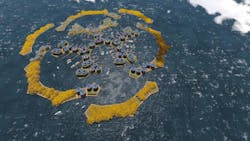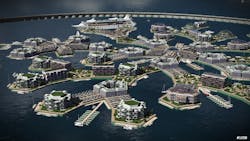Engineering a Waterborne Neighborhood and City
How would you like to live on the ocean in a stand-alone house or multi-story apartment building that is part of a working neighborhood floating off the coast of a large city or is part of an entire seaborne city moored off a reef? That’s the premise of a recent non-fiction book titled Seasteading: How Floating Nations Will Restore the Environment, Enrich the Poor, Cure the Sick, and Liberate Humanity from Politicians, by Joe Quirk and Patri Friedman.
I thought the engineering behind the concept could provide fodder for a good Machine Design article, especially their plans to make these seaborne neighborhoods mobile. But I worried it could be some sort of get-rich-quick floating Ponzi scheme, complete with glossy brochures (as seen in the photos here). So I contacted the Seasteading Institute, a non-profit think tank in San Francisco exploring the concept and evaluating various approaches for details.
They sent a link to a report that lists the six important objectives behind Seasteading: movability, dynamic geography, growth, seakeeping, safety, and water experience. It outlines the pros and cons of the different methods and approaches for reaching those goals. For example, for seakeeping, larger floating platforms are preferred to smaller ones based on their smooth ride and tamer reactions to waves. But too big and they get too expensive, so they rationalize a platform size of about 50 meters by 50 meters.
They also talk about making the platforms and groups of platforms mobile. They quickly dismiss built-in engines as being too expensive considering the platforms likely won’t move that often, maybe never. Instead they will likely rely on ocean tugs for transport.
The report covers a myriad of technical details such as how to anchor the platforms, where would be best to anchor or moor them, and how to generate electricity and take care of sewage.
For a copy of that fascinating report, "Seasteading Implementation Plan: Final Concept Report," click here.
I always thought of homesteading as a way for people with almost nothing to get a piece of land for free, then work and turn it into a farm or ranch and own it. With Seasteading, it seemed like you need to be fairly wealthy to afford a house or apartment or building, and you would probably need to pay pretty high utilities to maintain connections and services. So the two, homesteading and Seasteading, don’t seem very similar. I asked them if they worry that Seasteading could be seen as just a method for wealthy people to escape the burden of taking care of poor neighbors and the needy? And then to move if things get bad or they pollute and ruin a bay or atoll?
Their spokesperson replied: “I don’t think the goal of Seasteading is to own parts of the sea like you own a piece of land. It is important to keep the mobility and flexibility of floating urban development. In that case you can leave with your house whenever you want. The analogy with homesteading is more about creating space for people who are looking for new economic opportunities and freedom in their lives. This could be for various reasons: because opportunities in their current lives are lacking, because they are suppressed by a dictatorship; or because they are fed up with the current society (or government). Therefore, I think Seasteading is about giving opportunities for pioneers to try out new things (technologies, policies, laws, etc.) in a space when they are not constrained by outdated infrastructure networks, laws and societal structures that were invented in the 19th century or even earlier.
“Most of the current floating projects are still quite expensive, but so were the first mobile phones in the 1980s. Wealthy businesspeople paid a lot of money for the first (not so great) products just to be the first. Their payments created a market and opened the way for further technical development and cost reductions. Now we all have mobile phones for only a fraction of what the first people paid and they are also much better. With floating developments, it will be the same. We have studied the feasibility of creating affordable floating housing in countries such as the Philippines but also social floating housing in the Netherlands. I also had students studying floating bamboo foundations for countries such as Myanmar. In most cases the construction cost for floating are 10 to 20% higher than construction on land. However, because a water plot is much cheaper than a plot of land, the total project costs are very similar. In areas with high land costs, floating developments can even be cheaper than land developments.
“The environmental impact is very important. We study it in all our projects and have even created a new company Indymo to study the water quality impacts with underwater drones. In my opinion the ecological impact of any large-scale floating development should be monitored continuously and made available online real time and open source. Rather than paying for a location on the water, a floating city could pay with the environmental services it delivers to the coastal city or host nation. For example, by creating a positive ecological impact by taking the coastal city pollution and using it in floating algae systems to produce biofuel and feed for aquaculture. Permits could also be made conditional on the positive ecological impact a floating city has.”
I also asked if sea-going mobile countries were the ultimate aim, and wouldn’t that bring about the need for laws, a constitution, and even a currency? And would the city have to stay in international waters?
He replied: “I absolutely think we will see floating city-states in international waters in the future but the ultimate aim is to solve the world’s most urgent problems by making use of the oceans. Most of our planet is water but we still use it in a very primitive way. Whether it is climate change, food scarcity, the water crisis, or any other urgent global problem, the water offers a new and promising perspective. Our current land-based societies dramatically constrain technical development and the sustainability transition. In most cases we are forced to connect to the centralized electricity grid, the water network, the sewer system, etc. Even though decentralized sustainable technologies are already available. We can create a house that produces its own drinking water but the construction laws do not allow it. On the water we can unleash the full potential of sustainable technology but also experiment with new ways of bottom up governance, as an opposite to our current top down hierarchical government. Laws and currencies would be needed, but also things we cannot even imagine yet … would be a part of these new governance arrangements.”
I’m not sure how widespread this movement to live on the ocean will become, but it holds a certain attraction for me. There are already floating neighborhoods in the Netherlands, and the Seasteading Institute recently signed a Memorandum of Understanding with French Polynesia to work with them to create a sea zone with a governing framework where people can begin Seasteading.
Let me know if you are interested in more details by leaving a comment below.


